|
|
 |
|
|
The Infantry's Tanks
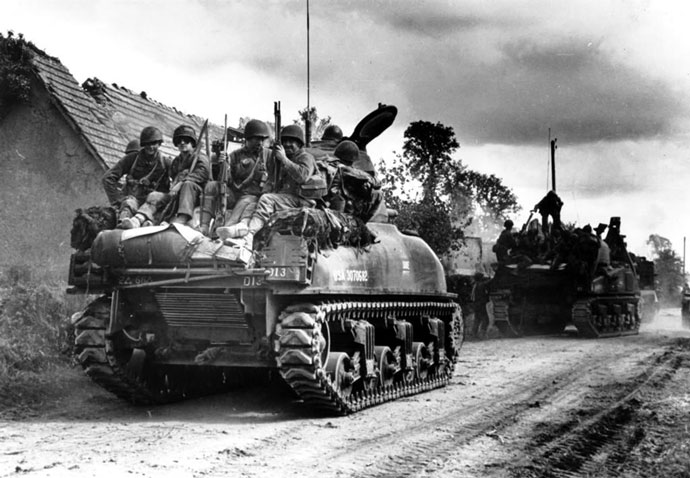 |
The Infantry's Tanks
by Mike Haught
Generally speaking, the Sherman tank served the US Army in two major roles. The first was to provide the backbone of the US armoured divisions. The second was in support of the infantry as separate tank battalions.
The armored divisions’ exploits are well known in their rapid advances across France after Operation Cobra had torn asunder the German lines near St. Lô. However, their success had much to do with their brothers-in arms in the infantry divisions. It was usually up to the doughboys of the infantry to break open a hole in the German lines so that the armoured divisions could pour into the gap and make their rapid advance.
|
|
Origins of the Tank Battalions
Taking to heart the lessons learned in the First World War, the US Army realized that for the infantry to do their job, they need firepower to overcome the enemy’s fortified positions. Like many nations, the USA adopted infantry support tanks to fill this role.
In an effort to consolidate designs and maximize production output, the US Army chose the M4 Sherman to serve the infantry in this capacity. Its all-round protection was suitable in the early years of the US involvement of the war, and it was relatively cheap and fast to produce.
|
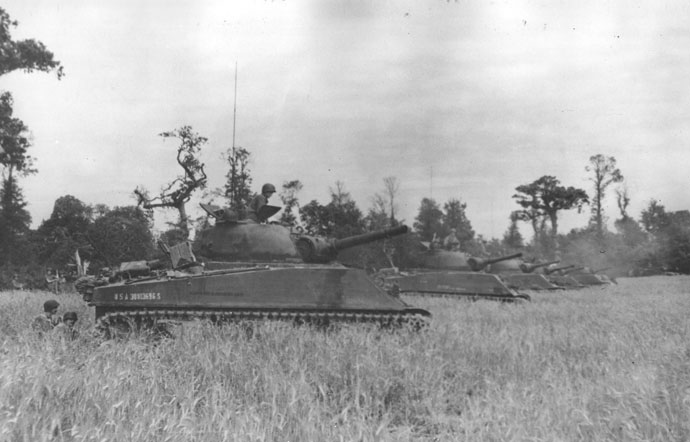 |
Tank Battalion Doctrine
Each infantry division was to have a battalion of Sherman tanks directly attached to give the infantry the capability of overcoming enemy positions. These battalions were not officially part of the division, but the majority of them stayed with their assigned division throughout the war.
They were organized exactly like a tank battalion from an armored division with three tank companies with medium tanks, and one company with light tanks. Each battalion had a battery of six assault guns and a small platoon of self-propelled 81mm mortars to provide smoke cover. |
| A tank battalion of an infantry division had a different mission than that of their armored division counterparts. The infantry’s four tank companies were to provide direct fire support to the division’s 27 rifle companies. As would be expected, these tankers were in high demand, and always involved in the thick of the action, blasting the enemy’s defences at close-range, counterattacking enemy breakthroughs, and reinforcing the strength and spirit of the men on the front lines. |
| The tankers of the infantry faced the bulk of the enemy’s anti-tank weaponry, such as anti-tank guns, tank-hunters, assault guns, and, occasionally, enemy tanks. The bulk of their opposition was the enemy’s infantry holding the front line. They encountered many hand-held anti-tank launchers such as Panzerfausts and Panzerschrecks. To deal with these weapons, the men of the tank battalions frequently added extra protection such as sand bags and logs. But their best protection came from their infantry comrades who were right there with them, fighting alongside them and taking out anti-tank weapons. In turn, the tanks took out the anti-infantry weapons, such as machine-guns. In this way an infantry-tank team would accomplish breakthroughs. |
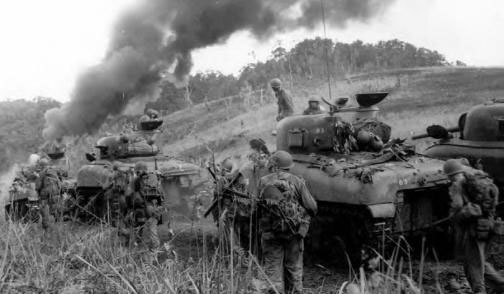 |
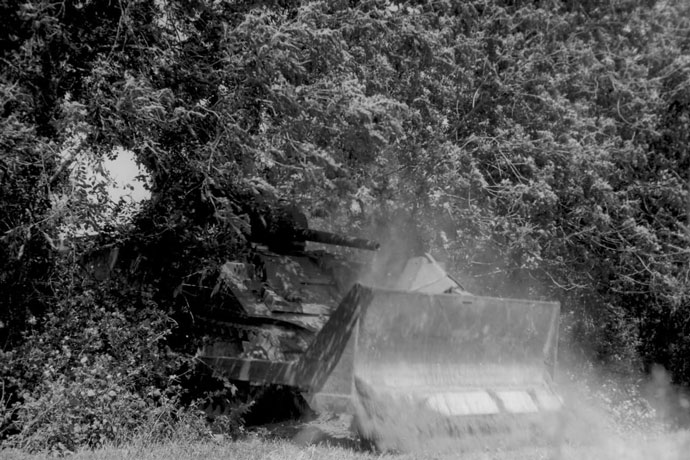 |
In the Field in Normandy
Normandy posed some serious challenges for the troops fighting there. Chief among them was bocage country with its tall impassable hedgerows sectioning the main battlefield into hundreds of tiny miniature battlefields. Just passing through a hedgerow as an infantryman was difficult enough, let alone doing it under fire. The tank battalions found it even more frustrating and slow, if not entirely impossible.
|
|
Traditional solutions, such as simply blowing a hole in the hedge using C4 explosives worked, but required preparation and often broadcasted the infantry’s intention to breech the hedgerow to the enemy. Dozer blades attached to the Sherman tank were also somewhat successful, but unpredictable and unreliable when large or wide hedges were encountered.
|
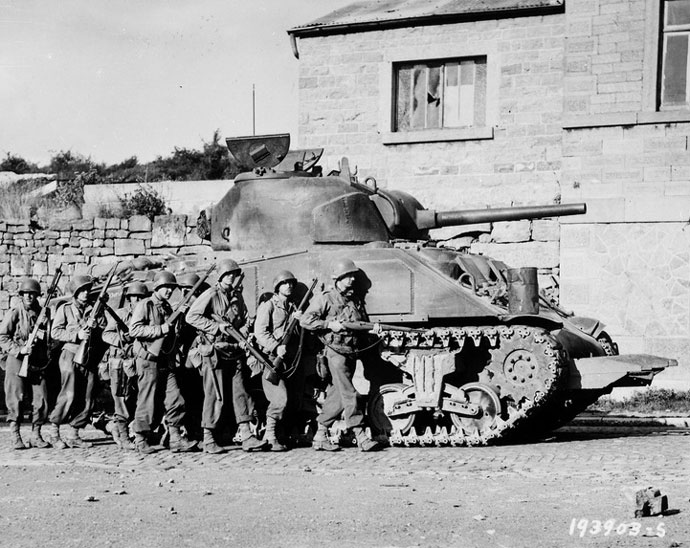 |
Sergeant Curtis G. Culin is credited to coming up with the ingenious solution. By fixing steel prongs to the front of a tank, it could run up to the hedgerow and plow its way through without losing much speed. It not only gave the tankers an answer to the hedgerow problem, it helped them retain the element of surprise as they could just suddenly smash through the hedge and catch the Germans on the other side before they could react. Furthermore, the hole left behind could be used by the infantry and support vehicles to support the tank. Soon about 60% of US tanks in Normandy had these Cullin Cutters, or Rhinos, attached and were leading the way during some of the most critical breakthroughs of the campaign.
|
|
One last innovation that transformed infantry-tank tactics was the tank telephone. Installed in the rear of the tank, this device would allow an infantry squad to communicate directly with the tank commander without having to expose either to unnecessary risk. This helped make sure that the infantry wouldn’t get bogged down by enemy machine-guns so long as a tank was nearby.
Beyond the Hedgerows
The fighting in Normandy had a major impact on how each infantry division would fight the rest of the war. They began taking on specific roles, stemming from the battles they were asked to fight. These roles would have an impact on how the tank battalion allocated its assets to the infantry.
|
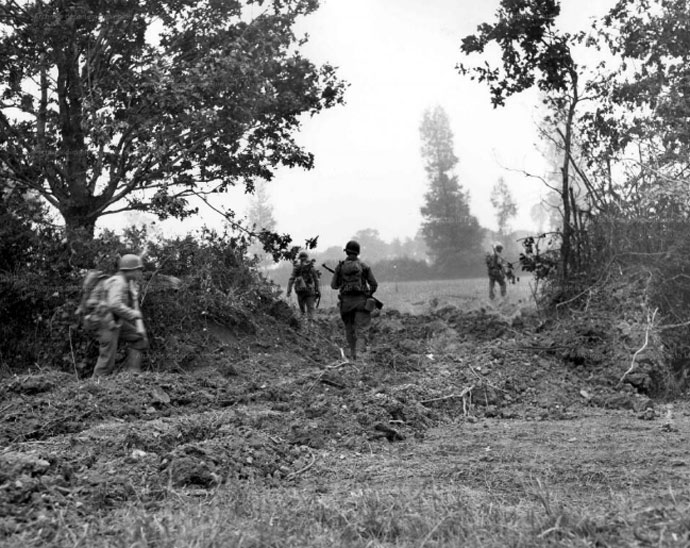 |
|
Some divisions excelled at methodical tank-infantry cooperation to achieve breakthroughs. These divisions tended to maximize their tank battalion across the entire frontage where their attack was happening. Assault companies could usually rely on about five tanks to help them with their mission. A slow methodical advance gave the infantry the time it needed to ensure the safety of the low number of assets, and likewise the tanks could make the most of their firepower.
Other divisions were held in reserve to attack German counterattacks or bail out another infantry division in trouble. Such missions required the division to be relatively mobile. In addition to its own transport company, the counter-attacking or advancing infantry divisions often employed the tank battalions as improvised transports to get places quick.
|
|
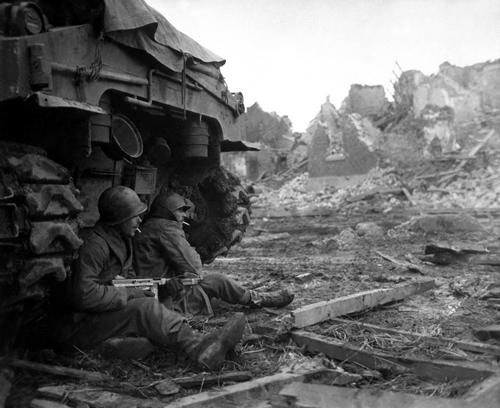
|
Rifle companies mounted up on M4 Shermans were a common sight, but some divisions took this a step further,. Using the tank as a tactical transport rather than a strategic one they created quick reaction task forces. In the case of the 35th Infantry Division, one regiment’s battalion was paired with the entire tank battalion and used to launch a wide flank attack on the Germans surrounding the 30th Infantry Division’s ‘lost battalion’ on Hill 314. The attacking infantry rode the tanks into battle, dismounting only to clear the way for the tanks. This tactic helped relieve the cut-off battalion, and the division and tank battalion added the tactic to their playsheet for future operations. |
|
Some divisions adopted a middle-of-the-road approach, allocating all of the tank battalion to a regimental attack, which would in turn keep the tanks together in company formations to support a battalion’s assault company. This gave the rifle company a good amount of tank support exactly where it was needed the most. This was particularly useful for attacks on very narrow assault frontages, such as in the case of the 2nd Infantry Division at Hill 192 or the 4th Infantry Division in the breakout assault for Operation Cobra. The divisions’ assault companies usually had two to three tank platoons in support during the attack, helping to overwhelm their German opposition.
Further Reading
For further reading I would recommend Harry Yeide’s The Infantry’s Armor, which follows the story of all independent tank battalions during the war.
|
|
Independent Tank Battalions in Flames Of War
Due to the mission of an infantry division’s tanks, it would be somewhat rare for a tank battalion to appear as a normal company in Flames Of War. With a ratio of four tank companies to 27 rifle companies in an infantry division, a typical Rifle Company in Flames Of War would be lucky indeed to get support from a platoon of the Tank Battalion, let alone more than that. This is represented by taking a Black Box Tank Platoon as a Support Unit.
However, sometimes your force is obviously pulled the lucky job of leading the assault and your divisional commander has allocated extra tanks to your command. In those rare situations where a Tank Battalion’s companies remained intact, such as at Hill 314, you can field a Formation of tanks by using the M4 Sherman Tank Company or Veteran M4 Sherman Tank Company form D-Day: American. One thing to note is that the independent tank battalion are unlikely to have M4 Sherman (76mm) tanks in their companies.
|
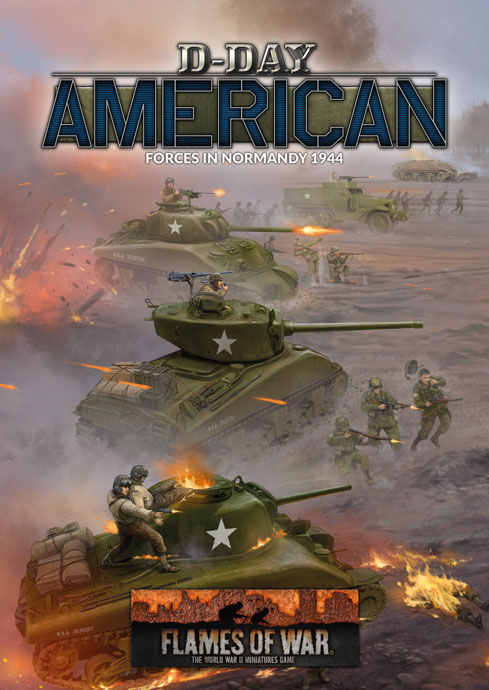 |
|
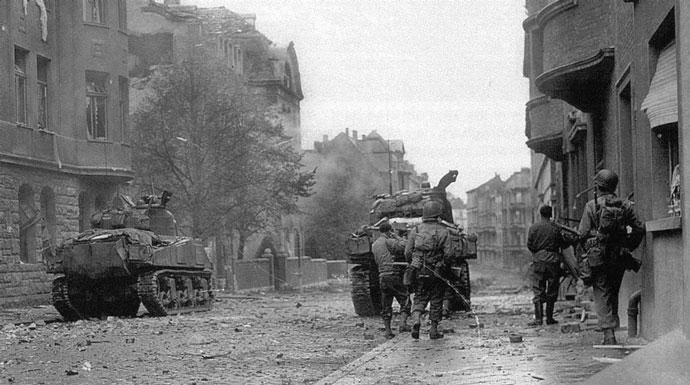
|
Last Updated On Thursday, May 28, 2020 by Wayne at Battlefront
|
|
|